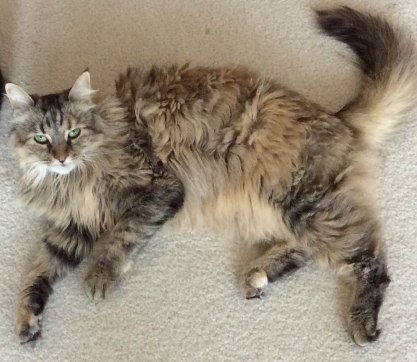One of the great things about the LilBUBome is that it’s an open science project, so we get to interact a lot with people who are interested in our science. One of these people is Ann, whom we got to know through Mike (BUB’s dude). Ann had contacted Mike a few months ago, because she also has a cat, Rosie, who was recently diagnosed with osteopetrosis, and Ann wanted to know more about the disease.
Of course, we were really fascinated by Ann & Rosie’s story: osteopetrosis is a rare disease, and even more rare in cats. BUB seems unique, because she’s the only cat with a juvenile (early-onset) form of the disease. Rosie’s case seems different.

A furball with piercing green eyes. Meet Rosie, another cat with osteopetrosis.
For example, she only developed osteopetrosis when she was older, so – unlike BUB – she’s actually quite long and lean (BUB is probably so small because her osteopetrosis forced her bones to calcify and stop growing too quickly).
Also, Rosie has different symptoms than BUB, and also received a different treatment. However, similarly to BUB she seems to be doing fine, despite living with osteopetrosis.
So, similarly to human patients with osteopetrosis, the disease seems to be rather diverse in cats, too. To get a better picture, we asked Anne to tell us Rosie’s story. Continue reading →



